Kansas’ Flint Hills Trail State Park: September 2025 Trail of the Month
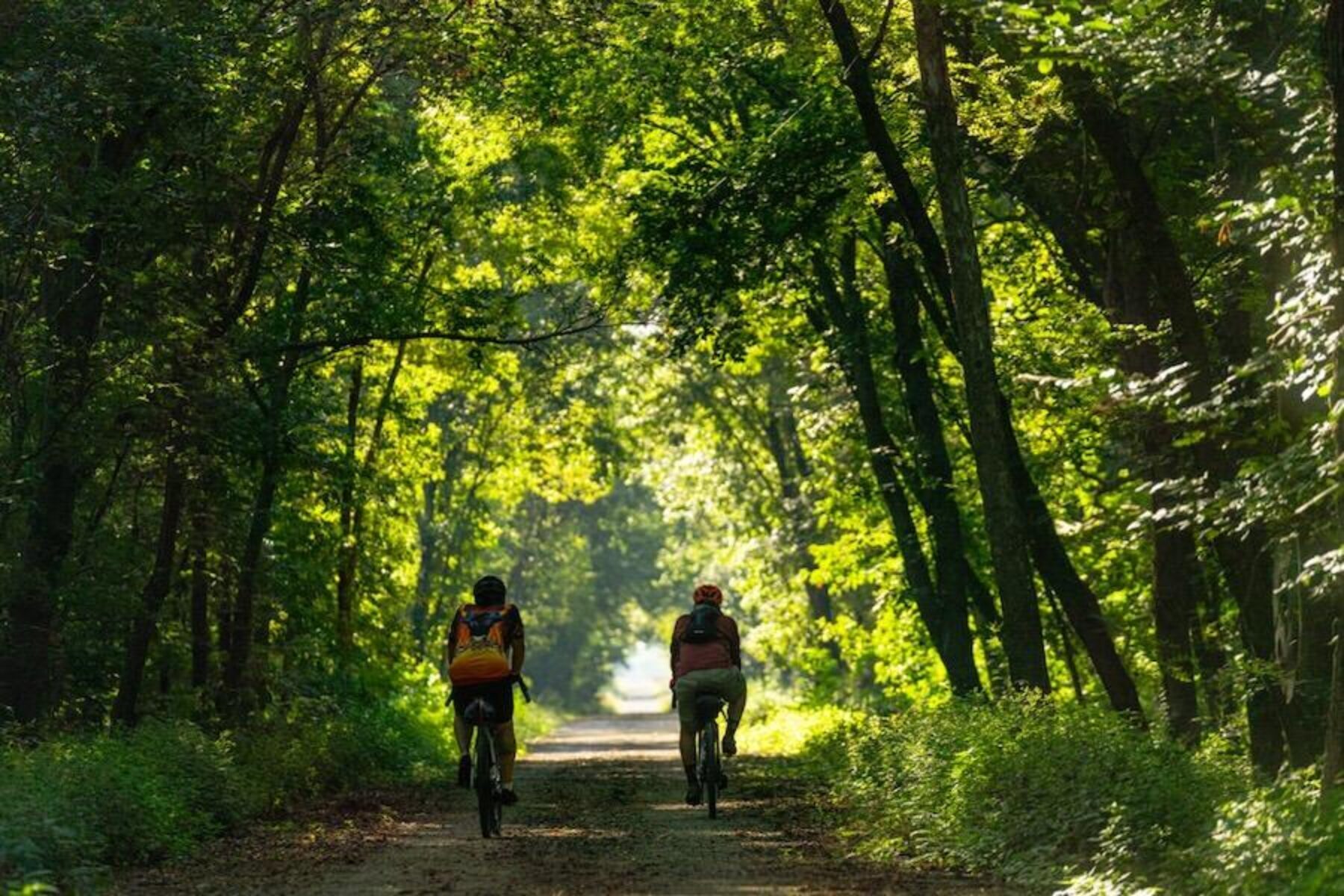
Explore the interesting history behind Kansas’ Flint Hills Trail State Park and how it’s positively impacting the rural communities along its route with new economic opportunities and connections to the region’s unique landscapes and culture.
Nestled in rural eastern Kansas, the 118-mile Flint Hills Trail State Park is one of the longest rail-trails in the country and encompasses some of America’s defining histories and experiences. In 2025, the trail earned its induction into Rails to Trails Conservancy’s Hall of Fame by garnering over 80% of the public vote to decide the winner among the nominees.
From Osawatomie to Herington, the route connects more than a dozen communities ranging in size from just 28 people to about 12,000. And it lies within 90 minutes of three of the state’s largest cities—Kansas City, Topeka and Wichita—helping to fuel its local economies through tourism and recreation. In 2022, a few of the towns along the trail got together and formed a group called the Kansas Association of Trail Towns, which later became Kansas Trails, Inc., to amplify the role of trails in driving this rural revitalization.
“One nice thing is that the towns are not in competition with each other,” explained Jeff Dorsett, a member of the Osawatomie Trail Commission. “People aren’t coming to just one location. They’re riding for 20 or 30 or 40 miles, so what’s good for one town is good for everybody.”

Cultural attractions along the trail that draw visitors include the Allegawaho Heritage Memorial Park, which honors the history of the Kaw (Kanza) Nation, and the John Brown Memorial Park and Museum State Historic Site, where visitors can learn about the abolitionist’s efforts to make Kansas a free state.
The Region’s Legacy
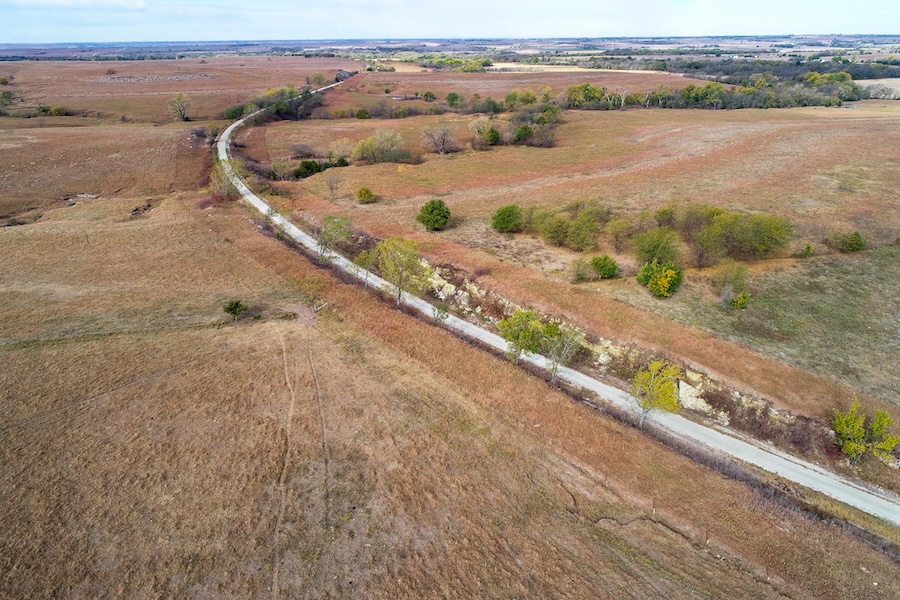
Sacred teachings of the Osage people tell of a time when Earth was covered in water. According to traditional oral storytelling (translated and recorded by Indigenous anthropologist Francis La Flesche), the Osage people sent messengers to search for land. Instead, they found the Great Elk, who threw himself into the water until the ground appeared. According to the Osage interviewed by La Flesche, “As he arose, the hairs of his body clung to the soil and became the grasses.”
While evidence of humans in the ancestral lands of the Osage, Wichita, Kansa and Pawnee nations in the Flint Hills region (and beyond) go as far back as 12,000 years, it’s true that the area was once covered in water. The Flint Hills, which make up part of the Great Plains, were once a vast and shallow sea during the Cretaceous period more than 100 million years ago and are covered in a sea of grasses today.
The trail traverses one of the last remaining tallgrass prairie ecosystems in the United States. At its peak, these prairies spanned 170 million acres, stretching from Canada to Mexico. Today, it’s estimated that only 4% of this ecosystem remains.
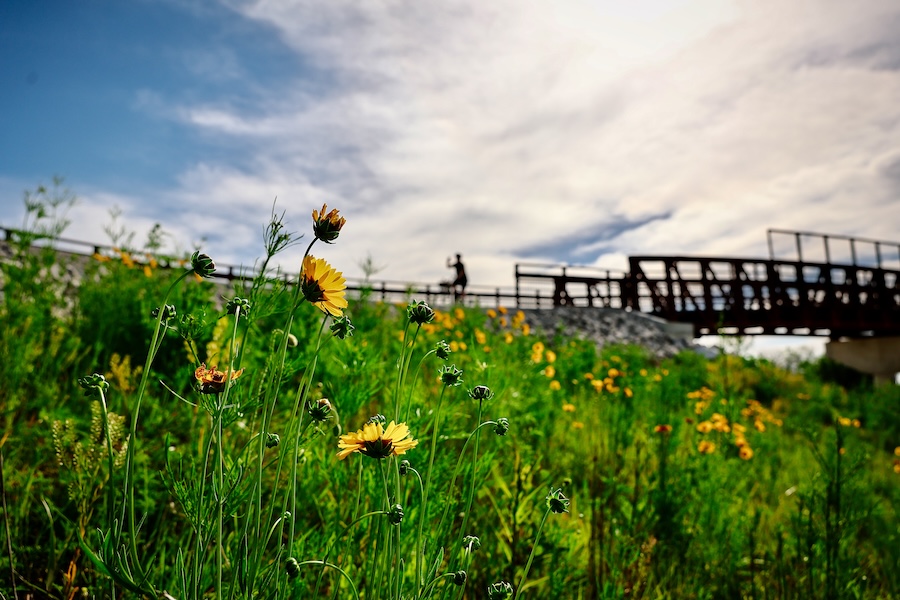
“The Flint Hills are a magical place, and the trail goes right through the heart of it,” said Jeffrey Bender, the Kansas Department of Wildlife and Parks’ regional parks supervisor. “It’s the expanse and preservation of the tallgrass prairie that makes this trail particularly unique.”
The trail also offers a journey through riparian woodlands and rolling farmland, along towering bluffs that hug the Marais des Cygnes River, and passage over historical railroad bridges.
The Burgeoning Trail
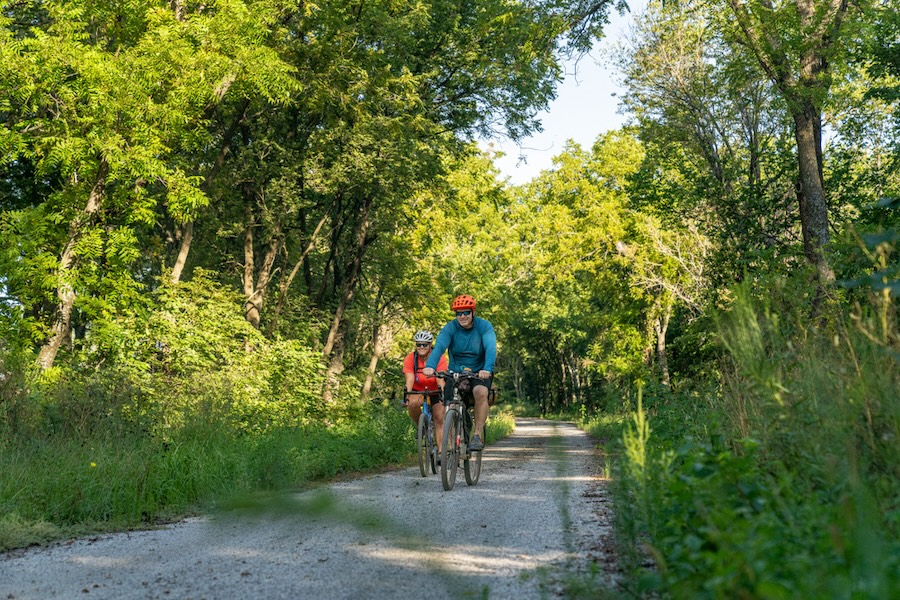
The Indigenous people that lived in the Great Plains area first encountered European settlers in the mid-1500s. By the late 1800s, the regions’ four nations—Osage, Wichita, Kansa and Pawnee—were forced to relocate. In 1886, the Council Grove, Osage City & Ottawa Railway, which would eventually become the Flint Hills Trail State Park, was completed. Trains would run on the line for a century before the railroad was decommissioned in the 1980s.
When Doug Walker, a local trail advocate, became a Kansas state senator in 1989, one of the first things he did in the role was work on trail-friendly policies. Back then, the Prairie Spirit Trail State Park faced opposition from some landowners and agricultural lobbyists. Constructed in stages, the first section of the eventual 51-mile pathway opened in 1996 and planted the seed for the Flint Hills Trail, which came later.
After the Missouri Pacific Railroad railbanked the Flint Hills corridor for conversion into a trail, it was transferred to the national nonprofit, Rails to Trails Conservancy, who then passed it on to a local group, the Kansas Horseman Foundation (now known as the Kanza Rail-Trails Conservancy), in 1997.

With just private donations and volunteer labor, Kanza Rail-Trails Conservancy spearheaded the development of the Flint Hills Trail and opened its first few miles in Osawatomie in 2003. Construction continued westward with a 17-mile section completed between Osawatomie and Ottawa in 2005. That same year, after leaving the state senate, Walker joined the board of the Kanza Rail-Trails Conservancy to continue helping with the trail project.
“Early on, many people thought it was a waste of money and a waste of time, but you don’t hear that too much anymore,” Walker said, noting that the sheer length of both rail-trails and the fact that they intersect has contributed to the growing popularity of trails in the state. “We have a pretty good trail network.”
Today, the juncture of these two now beloved trails is recognized at Ottawa’s Legacy Square, a 20,000-square-foot public space that can host large events, such as the special gathering that took place just this month to celebrate the Flint Hill Trail’s new Hall of Fame status.
At 73, Walker still volunteers to go out on the trails to help maintain them and enjoys spotting all the out-of-state license plates at the trailheads. At Osawatomie’s Mile Zero Trailhead, an informational kiosk stylized like a train depot is branded “Walker Station” in honor of his longtime efforts.
“Public opinion has changed tremendously,” Walker said. “As the trails developed, more people used them and they liked them. If you build it, they will come.”
A Bright Future

The Kansas Department of Wildlife and Parks began partnering with the Kanza Rail-Trails Conservancy in 2013 and five years later the trail officially became a state park. State and federal funding, including Transportation Alternatives grants, propelled the project forward.
As of May 2025, when a new 2.3-mile section fell into place, the Flint Hills Trail offers 93 miles of continuous, crushed-stone pathway between Osawatomie and Council Grove. Once the remaining 25 miles (between Council Grove and the west end of the trail in Herington)—which is currently still surfaced in its original railroad ballast—is improved, the trail’s full 118-mile length will be passable for walking, biking and horseback riding.
Bender explained that a 2022 grant for $24.8 million from the U.S. Department of Transportation’s Rebuilding American Infrastructure with Sustainability and Equity (RAISE) program will be used to help finish the trail.
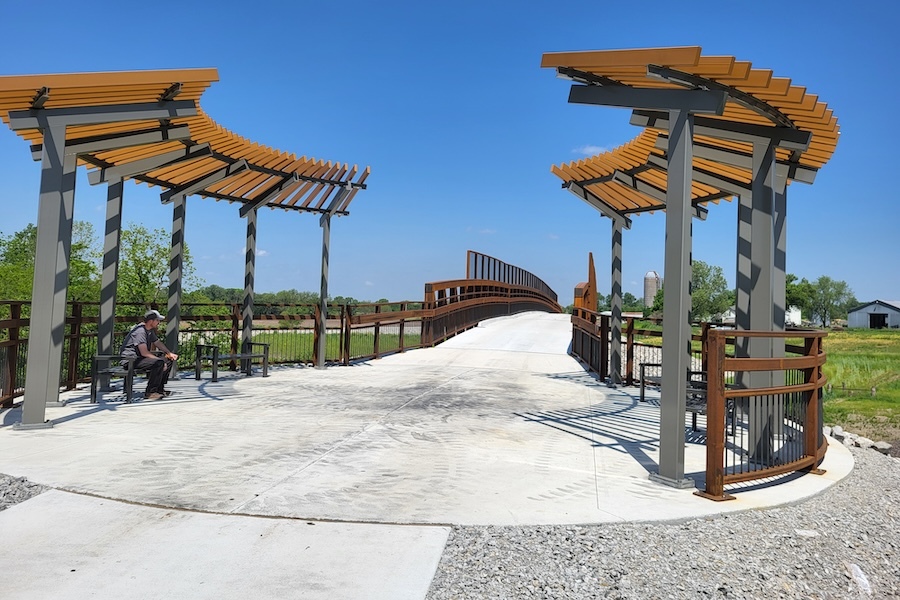
Already, the trail provides more than $1.8 million in annual economic impact to the communities along the route, according to a 2021 economic impact study conducted by Wichita State University’s Center for Economic Development and Business Research—a number that is expected to grow as more of the trail opens.
“The trail becomes community-building in the small towns especially,” said Bender, sharing as an example that a couple in the rural town of Allen recently “opened up a small campground that caters to bicyclists, and they’re getting ready to host a couple of events this fall.”
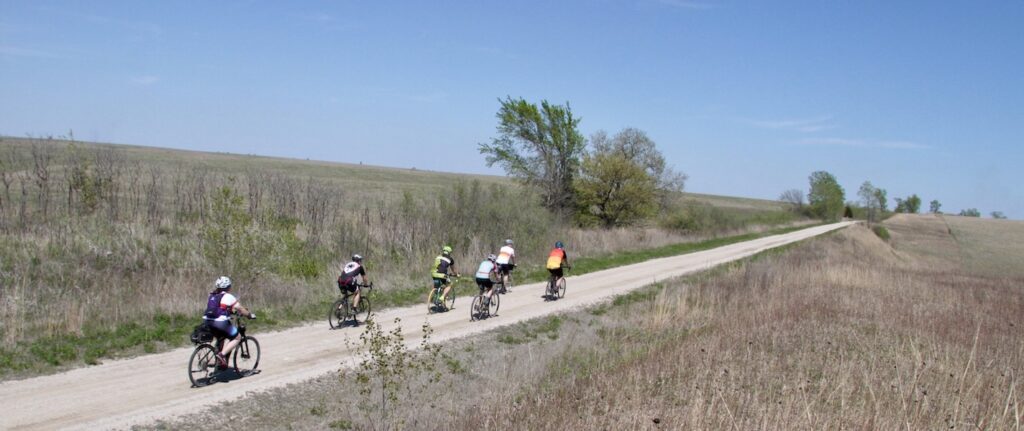
Jeff Carroll, shop owner of Ottawa Bike and Trail, can attest to the trail’s impact, too, noting that the growth of his business has been “exponential” since he opened his bike shop in 2018. “On the weekends, the parking lot behind our building has full bike racks with people coming down to visit.”

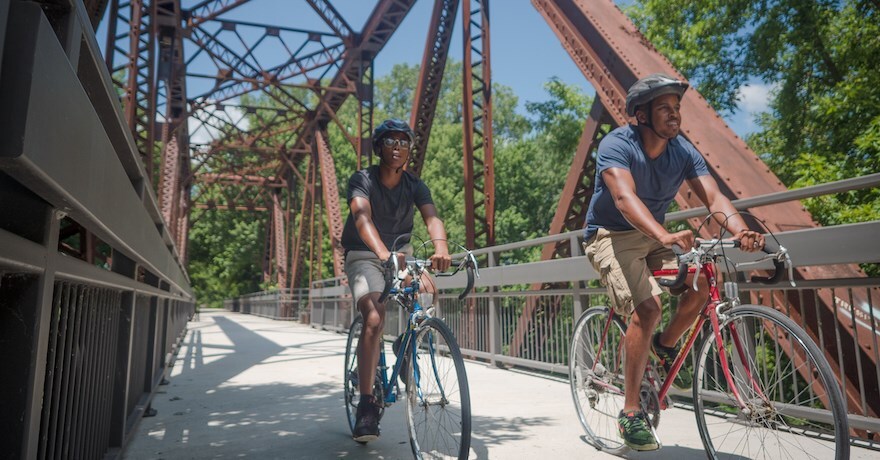
Related Links
Trail Facts
Name: Flint Hills Trail State Park
Used railroad corridor: Council Grove, Osage City & Ottawa Railway
Trail website: Kansas Department Wildlife and Parks
Length: Currently, the trail spans 93 miles; it will be 118 miles when completed.
County: Franklin, Lyon, Miami, Morris, Osage
Start point/end point: The trail currently begins at the Mile Zero Trailhead at 1400 South St. (Osawatomie) and extends 93 miles west to the trailhead at Walnut St. and Donnon St. (Council Grove). Eventually, the trail will continue another 25 miles west to Herington.
Surface type: Crushed limestone (for 93 miles from Osawatomie to Council Grove), ballast (for 25 miles from Council Grove to Herington)
Grade: The trail is generally level, with no noticeable inclines.
Uses: Walking, bicycling and horseback riding; wheelchair accessible
Difficulty: The 93-mile route from Osawatomie to Council Grove is considered easy to moderate. The 25 miles from Council Grove to Herington is railroad ballast and not yet passable.
Getting there: The closest major airport to the trail is the Kansas City International Airport, located about 70 miles from the east end of the Flint Hills Trail in Osawatomie.
Access and parking: There are more than a dozen parking locations along the Flint Hills Trail State Park, including the lots listed below from east to west.
- Osawatomie: Flint Hills Trail Mile Zero Trailhead, 1400 South St.; the parking area is large enough to accommodate horse trailers.
- Ottawa: Old Depot Museum, 135 W. Tecumseh St.; the museum also serves as an information center for the Prairie Spirit Trail, which intersects with the Flint Hills Trail in Ottawa.
- Pomona: Trailhead at 3012 Colorado Road; the parking area is large enough to accommodate horse trailers.
- Council Grove: Trailhead at Walnut St. and Donnon St.
To navigate the area with an interactive GIS map, and to see more photos, user reviews and ratings, plus loads of other trip-planning information, visit TrailLink™, RTC’s free trail-finder website.
Rentals: Bikes can be rented from Ottawa Bike and Trail (130 S. Main St., Ottawa; 913.951.1070), located just a block from the trail.
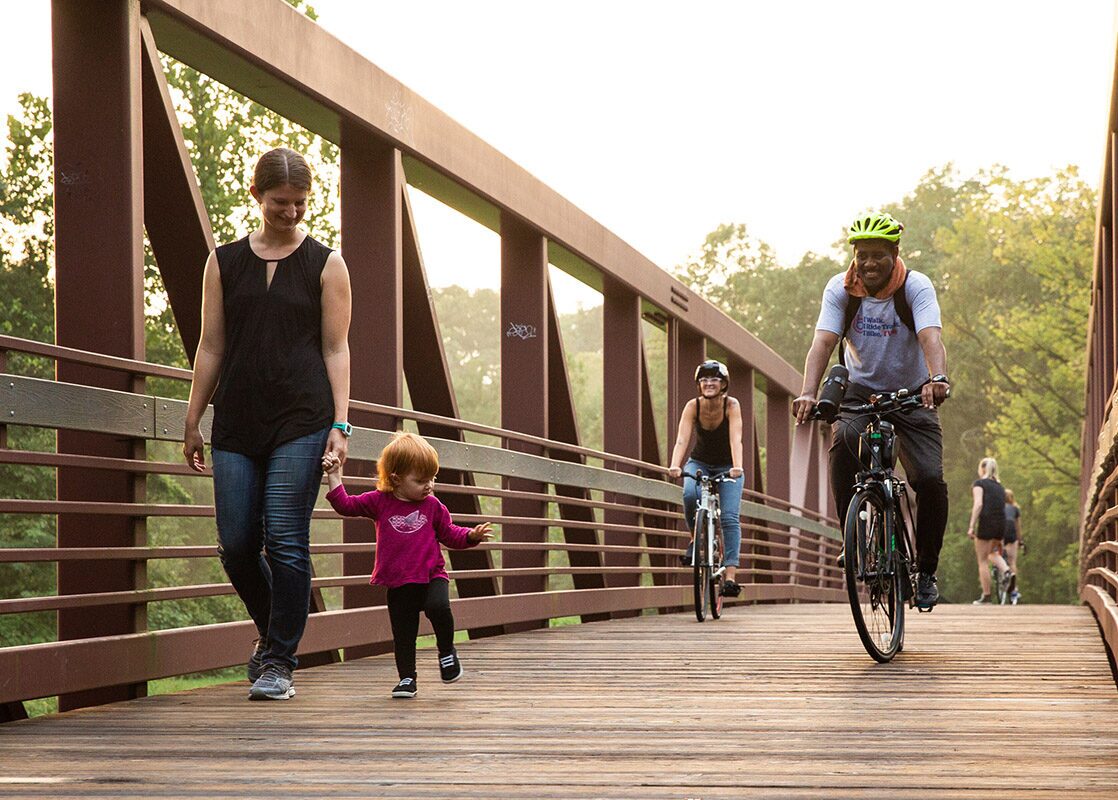
Donate
Everyone deserves access to safe ways to walk, bike, and be active outdoors.


